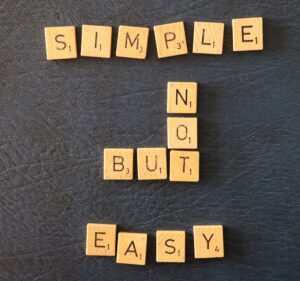
Just how hard can it be to learn the Alexander Technique? After all, it’s simply a case of being more aware of ourselves and our surroundings, and deciding to make more conscious choices over how we go about our daily lives.
Actually, it can be very easy to gain some basic understanding and skills, and it doesn’t usually take long for people to see at least some of the potential benefits. What is harder is putting the Alexander Technique into everyday practice. During their first few Alexander lessons, there’s often a point when the person turns to me – laughing, but with a hint of frustration – and says something along the lines of “Why do I always do that even though I’d decided not to?”
The playwright, George Bernard Shaw, who took lessons with FM Alexander, once insightfully commented “Yes, the Alexander Technique is simple…..but it’s not easy”.
So why is it that it can be difficult to put this amazingly powerful self-help method into practice?
First we need to recognise that, however logical the Alexander Technique is, it runs counter-cultural to deeply entrenched beliefs in our industrialised Western society. Our culture promises us quick fixes for our problems, and these always rely on doing something. With the Alexander Technique we are more interested in finding out what we are doing that might be causing problems, and then not doing, it. This removal of habitual interferences, enables us to harness our inherent ‘natural template’ for well-coordinated movement and balance to carry out the activities of daily living.
A further issue is that Western culture is profoundly dualistic, separating mind and body and leading us to think about ourselves as primarily a mind with an associated body. As such, activities can be artificially split into those that we think of as primarily physical e.g. moving, and those that we think of as primarily mental e.g. thinking itself. FM Alexander was insistent that we are indivisible mind-bodies. As such there is no such thing as a physical or a mental activity as the whole embodied person is always involved. It took me many years to appreciate the reality of this and its significance. I was always someone who ‘lived in my head’ with little awareness of my physical self. So, embarking on the Alexander Technique can require a completely different way of thinking about oneself.
Finally, and arguably the most pernicious reason why putting the Alexander Technique into practice is not always easy is the power of habit. Unless you begin learning very early in life, you will have had many years to develop deeply ingrained habits. The way that we walk, sit, speak, and even think is powerfully socialised. Not all habitual ways of doing things are bad but some of our habits do get in our way. If we want to change them, ‘willpower’ is unlikely to be sufficient. What is needed is a practical embodied self-help method that enables us to choose different pathways to the habitual ones, and that is what the Alexander Technique is.
All of this illustrates why you’re likely to need some help in navigating your way through until you become more proficient. With a little bit of patience and self-kindness, it gradually becomes easier to put the Alexander Technique into practice in daily life. With time, it’s even there for us in more challenging situations. An Alexander teacher* acts as a facilitator, support and enabling you to see and experience things differently, being by your side as you embark on an intriguing journey of self-discovery.
*Do ensure that they are STAT-registered

